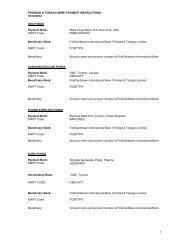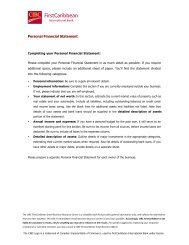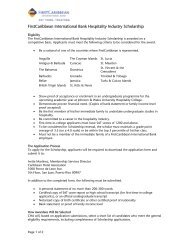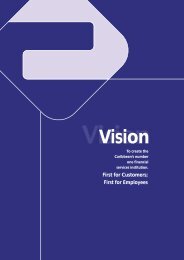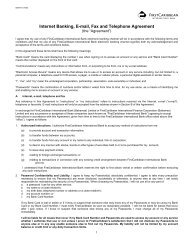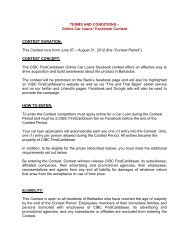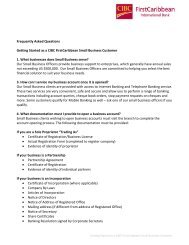Bahamas - FirstCaribbean International Bank
Bahamas - FirstCaribbean International Bank
Bahamas - FirstCaribbean International Bank
Create successful ePaper yourself
Turn your PDF publications into a flip-book with our unique Google optimized e-Paper software.
Notes to the Consolidated Financial Statements<br />
October 31, 2007<br />
(expressed in thousands of Bahamian dollars)<br />
2. Summary of significant accounting policies (continued)<br />
2.10 Impairment of non-financial assets<br />
The <strong>Bank</strong> assesses at each reporting date or more frequently if events or<br />
changes in circumstances indicate that the carrying value may be impaired,<br />
whether there is an indication that a non-financial asset may be impaired. If<br />
any such indication exists, or when annual impairment testing for an asset<br />
is required, the <strong>Bank</strong> makes an estimate of the asset’s recoverable amount.<br />
Where the carrying amount of an asset (or cash-generating unit) exceeds its<br />
recoverable amount, the asset (or cash-generating unit) is considered impaired<br />
and is written down to its recoverable amount.<br />
For assets, excluding goodwill, an assessment is made at each reporting date<br />
as to whether there is any indication that previously recognised impairment<br />
losses may no longer exist or may have decreased. If such indication exists,<br />
the recoverable amount is estimated. A previously recognised impairment<br />
loss is reversed only if there has been a change in the estimates used to<br />
determine the asset’s recoverable amount since the last impairment loss was<br />
recognised. If that is the case, the carrying amount of the asset is increased<br />
to its recoverable amount. Impairment losses relating to Goodwill cannot be<br />
reversed for subsequent increases in its recoverable amount in future periods.<br />
2.11 Offsetting financial instruments<br />
Financial assets and liabilities are offset and the net amount reported in the<br />
balance sheet when there is a legally enforceable right to offset the recognised<br />
amounts and there is an intention to settle on a net basis, or realise the asset<br />
and settle the liability simultaneously.<br />
2.12 Derivative financial instruments and hedge accounting<br />
The <strong>Bank</strong> makes use of derivative instruments to manage exposure to interest<br />
rate, foreign currency and credit risks, including exposures arising from<br />
forecast transactions. In order to manage particular risks, the <strong>Bank</strong> applies<br />
hedge accounting for transactions that meet the specified criteria.<br />
The <strong>Bank</strong>’s criteria for a derivative instrument to be accounted for as a hedge<br />
include:<br />
i) At inception of the hedge relationship, the <strong>Bank</strong> formally documents<br />
the relationship between the hedged item and the hedging instrument,<br />
See Auditors’ Report Page 56.<br />
ii)<br />
iii)<br />
including the nature of the risk, the objective and strategy for undertaking<br />
the hedge and the method that will be used to assess the effectiveness of<br />
the hedging relationship;<br />
Also at the inception of the hedge relationship, a formal assessment is<br />
undertaken to ensure the hedging instrument is expected to be highly<br />
effective in offsetting the designated risk in the hedged item. Hedges are<br />
formally assessed each quarter. A hedge is regarded as highly effective<br />
if the changes in fair value or cash flows attributable to the hedged risk<br />
during the period for which the hedge is designated are expected to<br />
offset in a range of 80% to 125%. For situations where that hedged item<br />
is a forecast transaction, the <strong>Bank</strong> assesses whether the transaction is<br />
highly probable and presents an exposure to variations in cash flows that<br />
could ultimately affect the consolidated statement of income. The hedge<br />
is expected to be highly effective in offsetting the risk in the hedged item<br />
throughout the reporting period; and;<br />
The hedge is highly effective on an ongoing basis.<br />
Derivatives are initially recognised in the balance sheet at their fair value<br />
based on settlement date. Fair values are obtained from discounted cash flow<br />
models, using quoted market interest rates. All derivatives are carried as assets<br />
when fair value is positive and as liabilities when fair value is negative.<br />
The method of recognising the resulting fair value gain or loss depends on<br />
whether the derivative is designated as a hedging instrument, and if so, the<br />
nature of the item being hedged. The <strong>Bank</strong> designates certain derivatives<br />
as either: (1) hedges of the fair value of recognised assets or liabilities (fair<br />
value hedge); or (2) hedges of highly probable cash flows attributable to a<br />
recognised asset or liability (cash flow hedge). Hedge accounting is used for<br />
derivatives designated in this way provided certain criteria are met.<br />
(1) Fair value hedges<br />
Changes in the fair value of derivatives that are designated and qualify<br />
as fair value hedges and that prove to be highly effective in relation to<br />
hedged risk, are recorded in the consolidated statement of income in<br />
‘Net trading income’, along with the corresponding change in fair value<br />
of the hedged asset or liability that is attributable to that specific hedged<br />
risk.<br />
If the hedging instrument expires or is sold, terminated or exercised, or<br />
where the hedge no longer meets the criteria for hedge accounting, the<br />
hedge relationship is terminated.<br />
67



